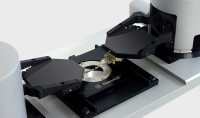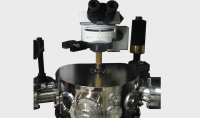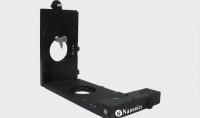Traditional fluorescence instruments including confocal microscopy do not have enough optical resolution for detection of nanoscale fluorescence objects.
NSOM fluorescence is a sensitive nano-optical technique which makes use of the fluorescence for near-field imaging and is especially suited for biological applications. Fluorescence is excited by a laser transmitted through the nanometric aperture of an NSOM probe and the emitted fluorescence is collected in far-field. Appropriate optical filters are used for removal of all primary laser light and detection of the emitted fluorescence. Optical resolution of NSOM fluorescence imaging is a function of the NSOM probe aperture and can be less than 50 nm. Topographic and fluorescence images are acquired simultaneously. Transmission or reflection fluorescence NSOM modes are used depending on the substrate transparency.
Key Features
-
The only technique allowing localized illumination without out-of-focus light which is impossible in Confocal, PALM\STORM or STED.
-
Ideal for substrates in liquid mediums where far field illumination is difficult.
-
Fluorescence excitation at nanopixel without bleaching of surrounding area
-
Real time image of both structure and fluorescence optical study at exact same location
-
Local illumination with no background light. Extra benefit is tuning fork feedback with no optical background at all
-
Ability to manipulate the position of the probe and sample in a nanometer increments
-
Ability to work in a liquid medium with free optical access from above and below; permits working with a water-immersion objective for clear optical view and integration with other optical devices as Raman
Exemplary Paper
Nanoscale Fluorescence Imaging of Single Amyloid Fibrils
Mukhopadhyay, S. (2012). Nanoscale Fluorescence Imaging of Single Amyloid Fibrils, J.Phys.Chem.Lett.2012,3,1783-1787(iv).
Amyloids are aggregates of proteins that become folded into the wrong shape, allowing many copies of that protein to stick together. These previously healthy proteins most often lose their normal function and form large fibrils. Amyloid formation is implicated in variety of human diseases. It is important to study individual fibrils to delineate the structural basis of supramolecular protein assemblies. Traditional fluorescence far-field spectroscopy is limited by the optical diffraction limit and cannot be used for characterization of the nanometric amyloids fibrils. This NSOM fluorescence high resolution techniques was applied to study morphological and optical properties of the individual amyloid fibrils.

Sample: Amyloid fibrils were prepared from β2-microglobulin, fluorescently stained with Nil Red die and deposited on fresh mica
Experimental setup: NSOM fluorescence measurements were performed using a Nanonics Scanning Probe Microscope MV-2000 integrated with an inverted optical microscope in transmission mode. A 488nm laser was transmitted through the NSOM probe for fluorescence excitation. The emitted fluorescent signal was collected in far-field with 50 x optical objectives. The 488 nm light was removed with notch and band pass filters and detected by APD.

Conclusion: Individual amyloid fibrils were imaged and analyzed with NSOM fluorescent microscopy with spatial resolution approx. 75nm. Analysis of the fluorescence brightness along the individual fibrils and differences in their average brightness of the fibrils indicate the heterogeneous structural distribution and hence variations in the supramolecular packing of the cross –β architecture.
Link to abstract
Exciting Applications
-
Study ion transport into membranes by using a Calcium sensitive dye and locally illuminating on a desired location on the membrane with no background light.
-
Study absorption properties of different materials or live organisms.
-
Study IR absorption in micron resolution by introducing IR light via an apertured NSOM probe.




